Online exhibition |
Armenian Book Printing in the Ottoman Empire

The Armenians were one of the firsts to make use of Gutenberg’s invention. Since 1512 they have established printing houses and published books in different corners of the world, where there were Armenian colonies. The Ottoman Empire was not an exception and in 1567 the first Armenian book was published in its capital, Constantinople. In time Constantinople became one of the main centers of the Armenian book printing and preserved its role till the beginning of the 20th century.
After a short typographic activity of Abgar Tokatetsi (1568 - 1569) and Yeremia Kyomurjian (1677-1678) in Constantinople, in the 17th century Sargis Evdokatsi’s, Grigor Marzvantsi’s and Astvatsatur Konstandnupolsetsi’s publishing houses were established, which ran constantly and had fruitful typographic activity for a long time. Among the famous Western Armenian publishers were also Pogos Arapian, Sargis Dpir, Chnchin Hovhannes and others. Till 1800 almost 350 Armenian books had been published only in Constantinople.
Next to the early religious and moral publications, historical, fiction, educational, scientific and other literature was published in Old and Modern Armenian, including translated and author’s literature.
The Armenian publishing houses were established in Smyrna, Armash, Van, Mush, Bursa, Adana, Adrianapole, Adabazar, Konya, Nicomedia, Samsun, Karin, Erznka, Evdokia, Kharberd, Amasia, Marzvan, Ayntap and elsewhere.
During the Armenian Genocide the printing houses that were functioning in Western Armenia and in the cities of the Ottoman Empire, mostly populated with Armenians, ceased their existence. During these years hundreds of printing houses, libraries and repositories of ancient manuscripts were destroyed, tens of thousands of Armenian books were burnt.
 From History of Armenian Printing Houses of Constantinople: block letters and template-clichés.
From History of Armenian Printing Houses of Constantinople: block letters and template-clichés.
 From History of Armenian Printing Houses of Constantinople: block letters and template-clichés.
From History of Armenian Printing Houses of Constantinople: block letters and template-clichés.
 "St. John’s Book of Revelation and Interpretation", Constantinople, 1700.
"St. John’s Book of Revelation and Interpretation", Constantinople, 1700.
 "Small and Nice Song-book, Songs Sung by Wise Poets", Constantinople, 1700.
"Small and Nice Song-book, Songs Sung by Wise Poets", Constantinople, 1700.
 "The Bible", Constantinople, the Printing House of Petros Latinatsi, 1705.
"The Bible", Constantinople, the Printing House of Petros Latinatsi, 1705.
 "Yasmavurk", Constantinople, the Printing House of Marzvantsi, 1706.
"Yasmavurk", Constantinople, the Printing House of Marzvantsi, 1706.
 Agatangeghos, "History of Armenians", Constantinople, the Printing House of Grigor Marzvantsi, 1709.
Agatangeghos, "History of Armenians", Constantinople, the Printing House of Grigor Marzvantsi, 1709.
 Zenob Glak, "Book about the History of Taron", Constantinople, the Printing House of Grigor Marzvantsi, 1719.
Zenob Glak, "Book about the History of Taron", Constantinople, the Printing House of Grigor Marzvantsi, 1719.
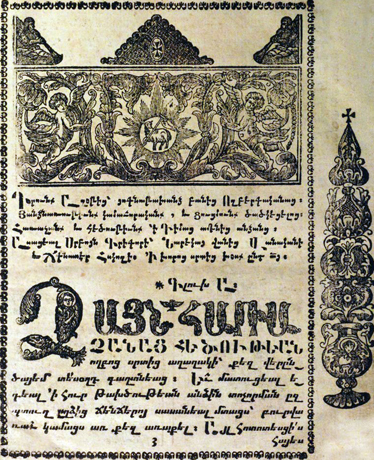 Grigor Narekatsi, "Prayer Book", Constantinople, the Printing House of Hovhannes and Poghos, 1782.
Grigor Narekatsi, "Prayer Book", Constantinople, the Printing House of Hovhannes and Poghos, 1782.
 "Book of Life for Children: Religious Songs, Precepts and Real Histories", Smyrna, Homan Hallok Printing House, 1838.
"Book of Life for Children: Religious Songs, Precepts and Real Histories", Smyrna, Homan Hallok Printing House, 1838.
 "Pedagogue that Gives Useful Talks to Educate Boys", Smyrna, Homan Hallok Printing House1839.
"Pedagogue that Gives Useful Talks to Educate Boys", Smyrna, Homan Hallok Printing House1839.
 "The Life of Patriarchs and Prophets (Conversations with Useful Precepts and Examples)", Smyrna, Homan Hallok Printing House, 1839.
"The Life of Patriarchs and Prophets (Conversations with Useful Precepts and Examples)", Smyrna, Homan Hallok Printing House, 1839.
 "Book of Confession", Smyrna, Homan Hallok Printing House, 1839.
"Book of Confession", Smyrna, Homan Hallok Printing House, 1839.
 "Song-book of the Armenian St. Church", Hortagyugh, the Printing House of Poghos Arapian’s sons.
"Song-book of the Armenian St. Church", Hortagyugh, the Printing House of Poghos Arapian’s sons.
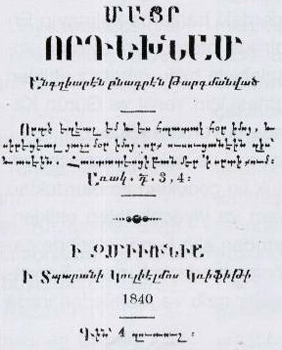 "Mother Taking Care of Her Child", Translated from the Original English text, Smyrna, Kulielmous Krift’s Printing House, 1840.
"Mother Taking Care of Her Child", Translated from the Original English text, Smyrna, Kulielmous Krift’s Printing House, 1840.
 "Armenians’ National Constitution", Constantinople, 1863.
"Armenians’ National Constitution", Constantinople, 1863.
 Carlo Goldoni, "The Virtue of Bamelatsi", Comedy, Smyrna, Teteian Printing House, 1866.
Carlo Goldoni, "The Virtue of Bamelatsi", Comedy, Smyrna, Teteian Printing House, 1866.
 "Grammar Textbook for Elementary Schools", Constantinople, Hovhannes Terotents’ Printing House, 1870.
"Grammar Textbook for Elementary Schools", Constantinople, Hovhannes Terotents’ Printing House, 1870.
 "Women’s Secret, Translated from a 400-year Old Manuscript, by Armenian Archbishop Hovhannes", Constantinople, 1876.
"Women’s Secret, Translated from a 400-year Old Manuscript, by Armenian Archbishop Hovhannes", Constantinople, 1876.
 "Health and Physical Care for the Youth", Aram Ashjian's Printing House, 1886.
"Health and Physical Care for the Youth", Aram Ashjian's Printing House, 1886.
 Minas G. Minasian, "Musical Education According to the European Norms", Constantinople, Hovsep Galafian's Printing House, 1887.
Minas G. Minasian, "Musical Education According to the European Norms", Constantinople, Hovsep Galafian's Printing House, 1887.
 Priest Hovhannes Mavian, "Principal of Moral Education", Nicomedia, Armash of Van Printing House, 1889.
Priest Hovhannes Mavian, "Principal of Moral Education", Nicomedia, Armash of Van Printing House, 1889.
 "Triennial Reference Book of the Eastern Economic Union, Established on March 9, 1886", Constantinople, G. Paghtatlian Printing House, 1889.
"Triennial Reference Book of the Eastern Economic Union, Established on March 9, 1886", Constantinople, G. Paghtatlian Printing House, 1889.
 Levon Mkrtchian, "Marriage Problems; Man - Woman", Constantinople, 1894.
Levon Mkrtchian, "Marriage Problems; Man - Woman", Constantinople, 1894.
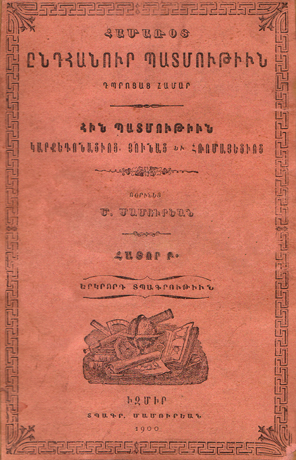 M. Mamurian, "General History for Schools in Brief", II volume. Second edition, Smyrna, Mamurian Printing House, 1899.
M. Mamurian, "General History for Schools in Brief", II volume. Second edition, Smyrna, Mamurian Printing House, 1899.
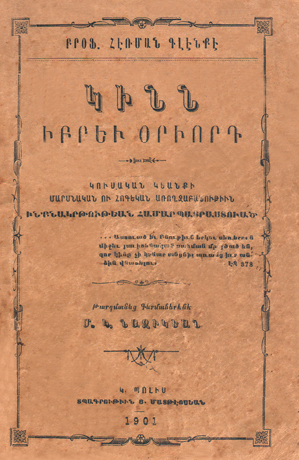 Herman Glenke, "Female as a Virgin, Hygiene of Physical and Spiritual Health of Virgin Life", translation from German by M.K. Nazikian, Y. Mateosian Printing House, Constantinople, 1901.
Herman Glenke, "Female as a Virgin, Hygiene of Physical and Spiritual Health of Virgin Life", translation from German by M.K. Nazikian, Y. Mateosian Printing House, Constantinople, 1901.
 K. S. Tukhmanian, "Commercial and Economic World", Smyrna, Mamurian Printing House, 1902.
K. S. Tukhmanian, "Commercial and Economic World", Smyrna, Mamurian Printing House, 1902.
 Karapet Solakhian, "Reference Book of a Merchant", Part A, Constantinople, Sarian and Friends Printing House, 1903.
Karapet Solakhian, "Reference Book of a Merchant", Part A, Constantinople, Sarian and Friends Printing House, 1903.
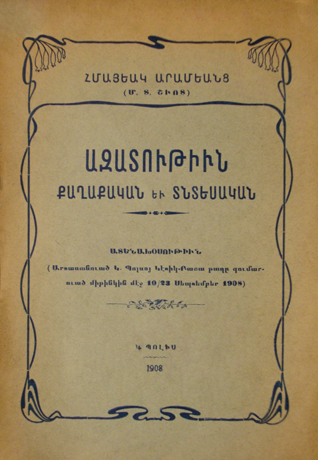 Hmayak Aramiants, "Political and Economic Freedom", Constantinople, 1908.
Hmayak Aramiants, "Political and Economic Freedom", Constantinople, 1908.
 Malkhas, "Current Starvation and Its Causes", Trebizond, Meshveret Printing House, 1909.
Malkhas, "Current Starvation and Its Causes", Trebizond, Meshveret Printing House, 1909.
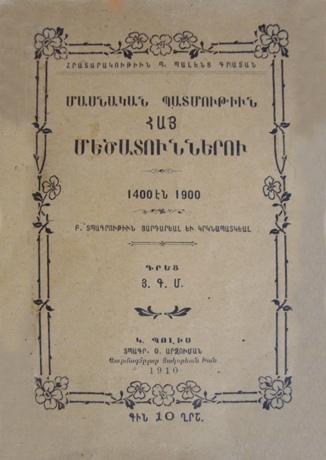 Y.G.M., "Private History of the Armenian Wealthy", Constantinople, O. Arzuman Printing House, 1910.
Y.G.M., "Private History of the Armenian Wealthy", Constantinople, O. Arzuman Printing House, 1910.
 "Code of Rules for Non-Muslim Elements’ Enlistment", translation by K. Solakhian, Constantinople, O. Arzuman Printing House, 1910.
"Code of Rules for Non-Muslim Elements’ Enlistment", translation by K. Solakhian, Constantinople, O. Arzuman Printing House, 1910.
 R. Asasian, "Little Hero: From the Turkish Life", Evdokia, 1911.
R. Asasian, "Little Hero: From the Turkish Life", Evdokia, 1911.
 Sarah Nelson Carter, "For the Sake of Love and Mercy: Love Animals and Adore Them", Constantinople, O. Arzuman Printing House, 1911.
Sarah Nelson Carter, "For the Sake of Love and Mercy: Love Animals and Adore Them", Constantinople, O. Arzuman Printing House, 1911.
 Hovhannes Hakobian, "Civic Education", Constantinople, Y. Mateosian Printing House, Constantinople, 1911.
Hovhannes Hakobian, "Civic Education", Constantinople, Y. Mateosian Printing House, Constantinople, 1911.
 Tiran Muradian, "Guide for Reading and Translation from English", year B, Constantinople, 1911.
Tiran Muradian, "Guide for Reading and Translation from English", year B, Constantinople, 1911.
 G. Gojaian, "Armenian Sighs: Patriotic and Religious poems", Marzvan, Nerso and Srapian Printing House, 1911.
G. Gojaian, "Armenian Sighs: Patriotic and Religious poems", Marzvan, Nerso and Srapian Printing House, 1911.
 Mamikon Varjapetian, "Conversations: Review of Some Significant Issues of the Armenian Reality, Practical Direction Pointing out to the Mistakes and Solutions", Marzvan, Nerso and Srapian Printing House, 1911.
Mamikon Varjapetian, "Conversations: Review of Some Significant Issues of the Armenian Reality, Practical Direction Pointing out to the Mistakes and Solutions", Marzvan, Nerso and Srapian Printing House, 1911.
 Gh. Meloian, "Pictures", book A, Kirason, Petak Printing House, 1912.
Gh. Meloian, "Pictures", book A, Kirason, Petak Printing House, 1912.
 G. Vardapetian, "Topographic Geography of National Schools of Amasya", Prepared for the First Two 2 Months of III form, for 1911-1912, Amasya, Pokr Hayk Printing House, 1912.
G. Vardapetian, "Topographic Geography of National Schools of Amasya", Prepared for the First Two 2 Months of III form, for 1911-1912, Amasya, Pokr Hayk Printing House, 1912.
 "Program and Code of Rules of the Priesthood Union of Constantinople", Constantinople, 1912
"Program and Code of Rules of the Priesthood Union of Constantinople", Constantinople, 1912
 A. Totel, "Mousses or Darwin", translated by Gurgen N. Papazian, Kirason, Petak Printing House, 1912.
A. Totel, "Mousses or Darwin", translated by Gurgen N. Papazian, Kirason, Petak Printing House, 1912.
 "Pocket Book of New Patriotic Songs", Marzvan, Nerso and Srapian Printing House, 1913.
"Pocket Book of New Patriotic Songs", Marzvan, Nerso and Srapian Printing House, 1913.
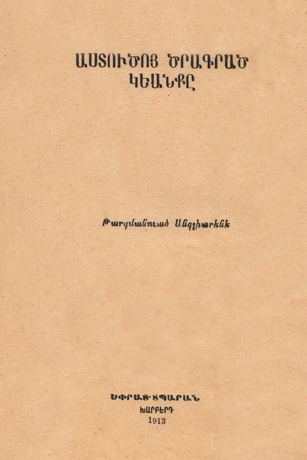 "Life Planned by God", translation from English, Kharberd, Eprat Printing House, 1913.
"Life Planned by God", translation from English, Kharberd, Eprat Printing House, 1913.
 S. Piperjian, "New Political, Statistical and Commercial Pocket Atlas", Constantinople, Sanjagjian Printing House, 1914.
S. Piperjian, "New Political, Statistical and Commercial Pocket Atlas", Constantinople, Sanjagjian Printing House, 1914.
 Tigran Bolatian, "7 String Lyre", Sebastia, Kabira K. A. Parsamian Printing House, 1914.
Tigran Bolatian, "7 String Lyre", Sebastia, Kabira K. A. Parsamian Printing House, 1914.
 "Program and Code of Rules of Shavarshian Student Union at Anatolia College", Marzvan, Anatolia Printing House (Y. M. Srapian), 1915.
"Program and Code of Rules of Shavarshian Student Union at Anatolia College", Marzvan, Anatolia Printing House (Y. M. Srapian), 1915.
 Alper Lavinia, "Musical Education", translation by Mihran Tarentelian, Constantinople, 1919.
Alper Lavinia, "Musical Education", translation by Mihran Tarentelian, Constantinople, 1919.
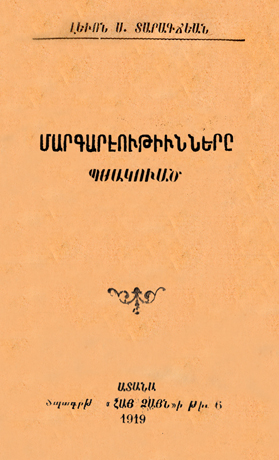 Levon S. Taragjian, "Fulfilled Prophecy", Adana, Hay Dzayn Printing House, 1919.
Levon S. Taragjian, "Fulfilled Prophecy", Adana, Hay Dzayn Printing House, 1919.
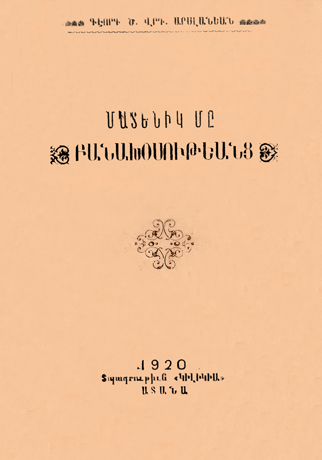 Manuscript of Reports, "Gevorg Arslanian", Adana, Cilicia Printing House, 1920.
Manuscript of Reports, "Gevorg Arslanian", Adana, Cilicia Printing House, 1920.
|
|
|
DONATE |

TO KEEP THE MEMORY OF THE ARMENIAN GENOCIDE ALIVE
Special Projects Implemented by the Armenian Genocide Museum-Institute Foundation
|
COPYRIGHT |

|
AGMI BOOKSTORE |
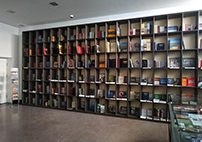
The Armenian Genocide Museum-Institute’s “World of Books”
|
TESTIMONIAL OF ARMENIAN GENOCIDE SURVIVORS |
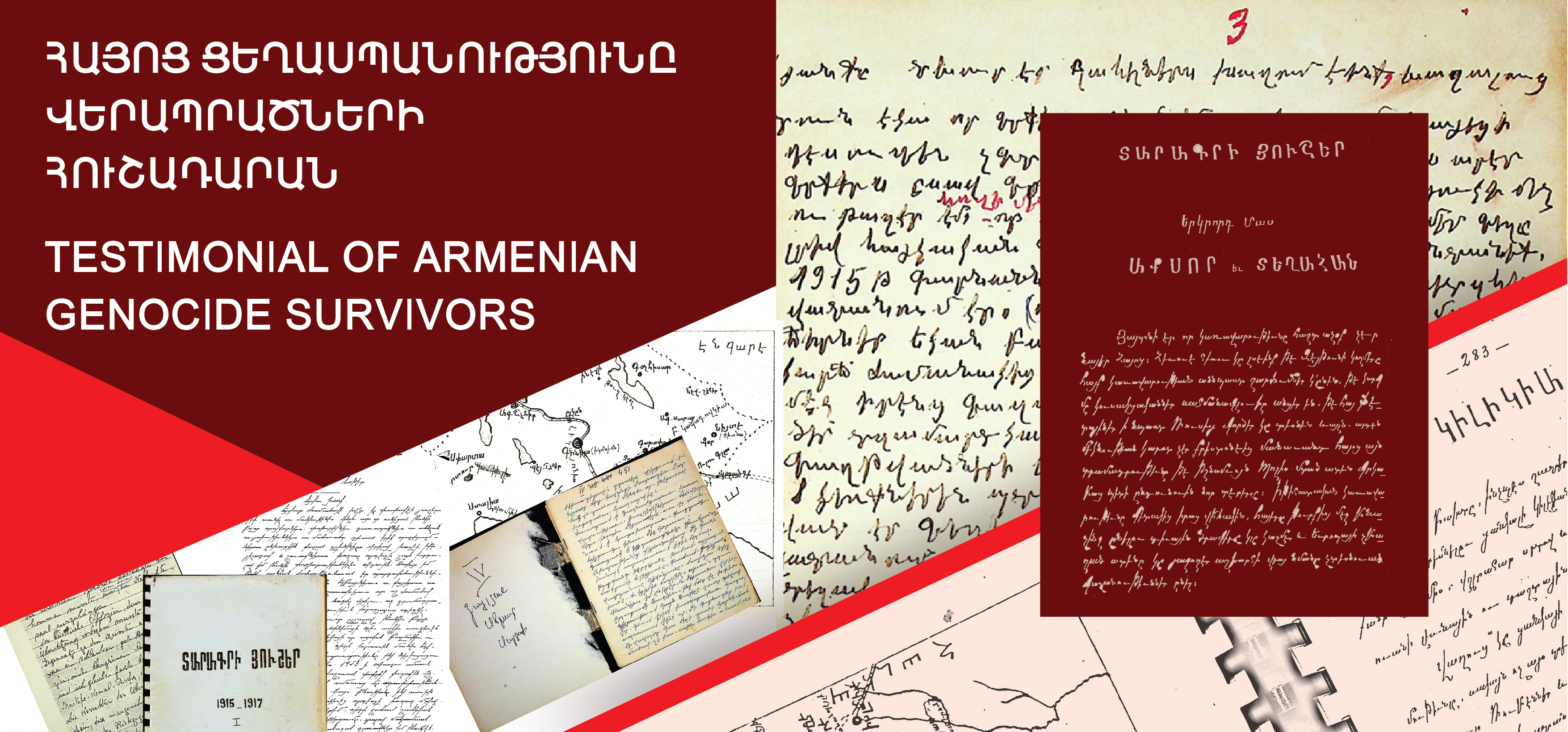
THE AGMI COLLECTION OF UNPUBLISHED MEMOIRS
|
ONLINE EXHIBITION |

SELF-DEFENSE IN CILICIA DURING THE ARMENIAN GENOCIDE
DEDICATED TO THE CENTENNIAL OF THE SELF-DEFENSE BATTLES OF MARASH, HADJIN, AINTAB
|
LEMKIN SCHOLARSHIP |

AGMI ANNOUNCES 2024
LEMKIN SCHOLARSHIP FOR FOREIGN STUDENTS
|
TRANSFER YOUR MEMORY |
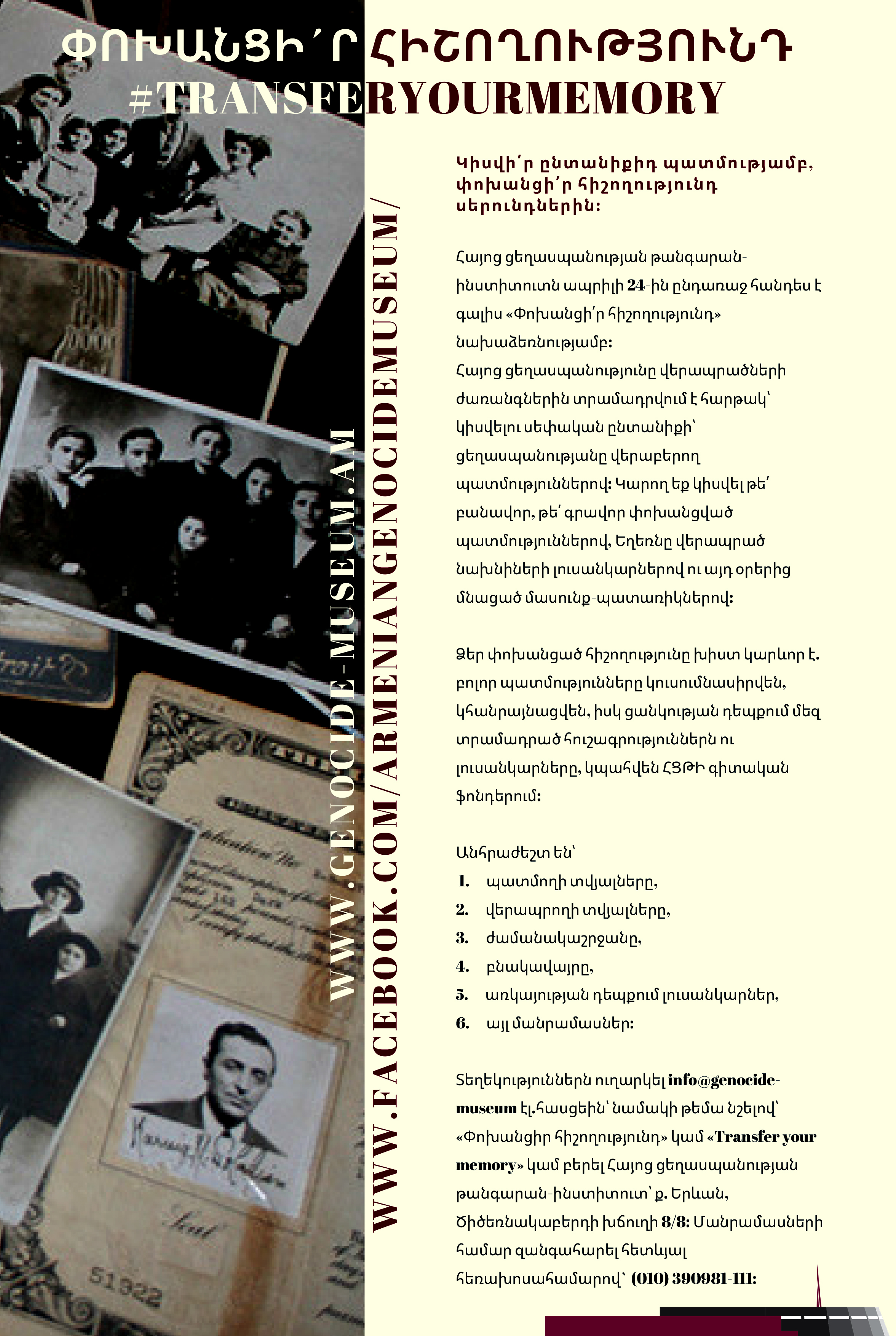
Share your family story,
Transfer your memory to generations.
On the eve of April 24, the Armenian Genocide Museum-Institute undertakes an initiative “transfer your memory”.
|
|





